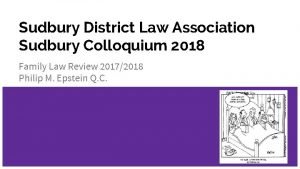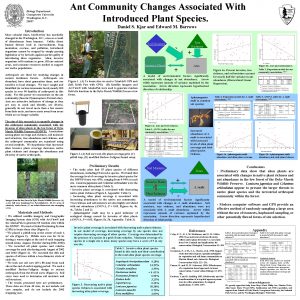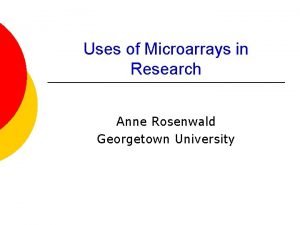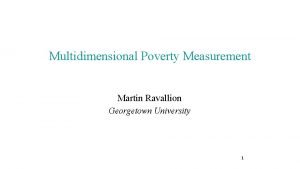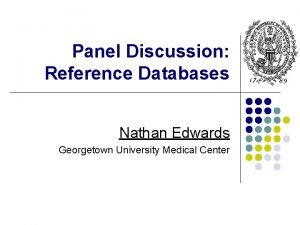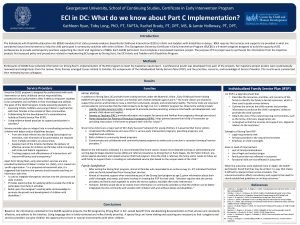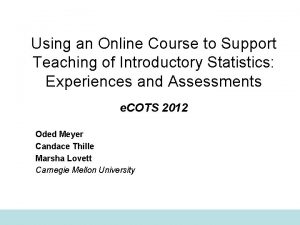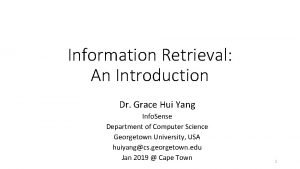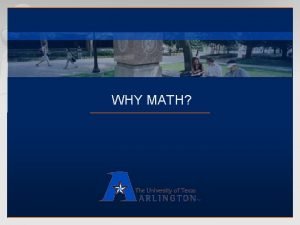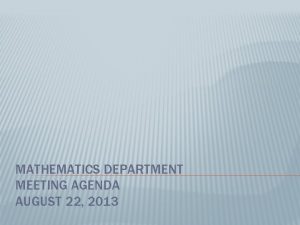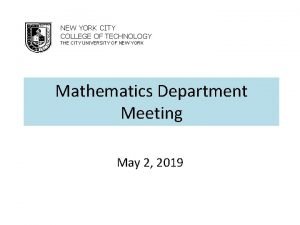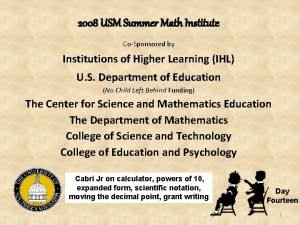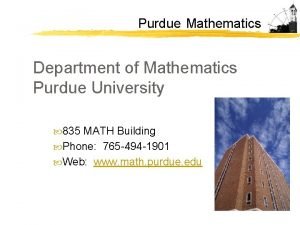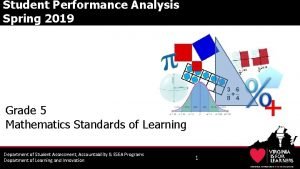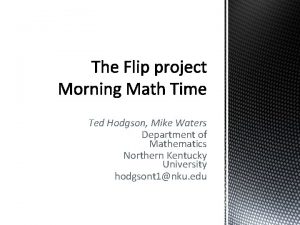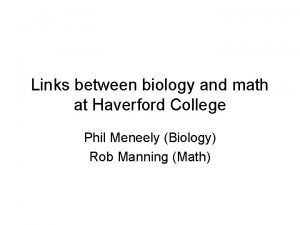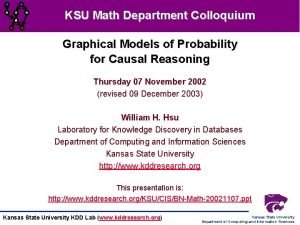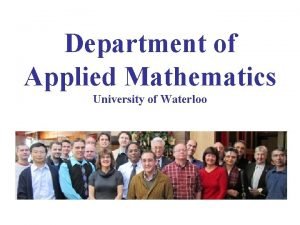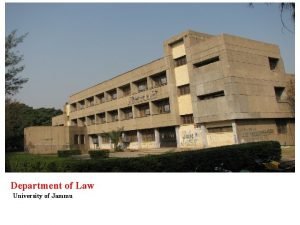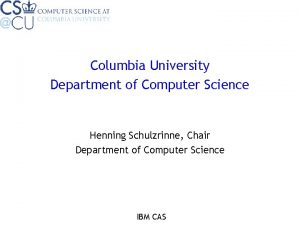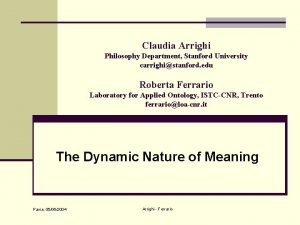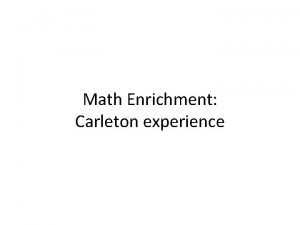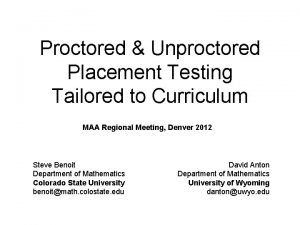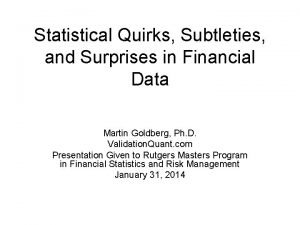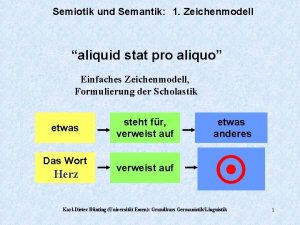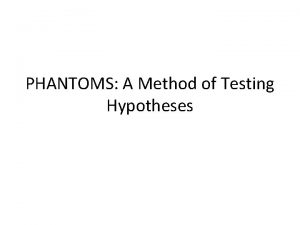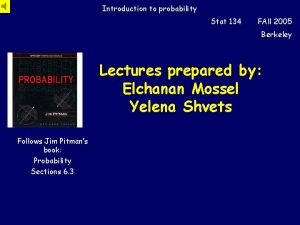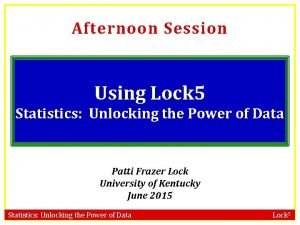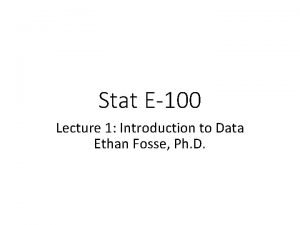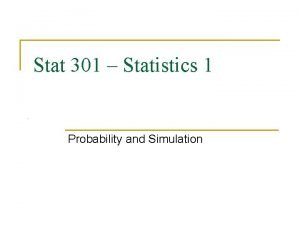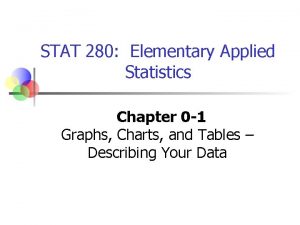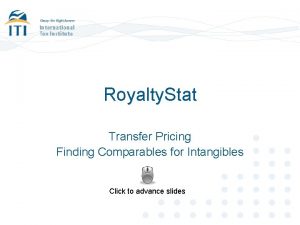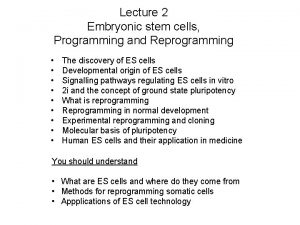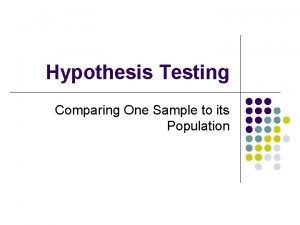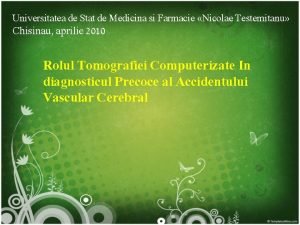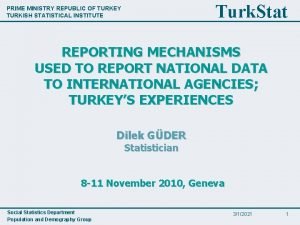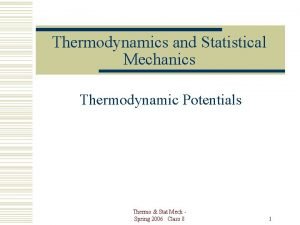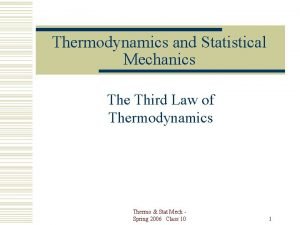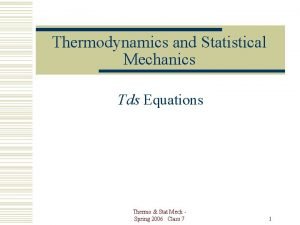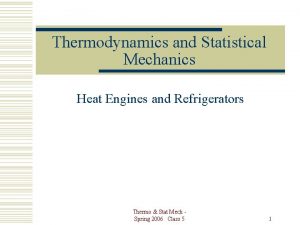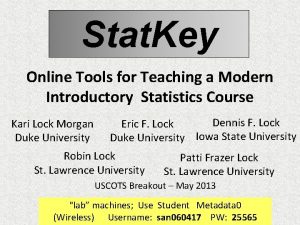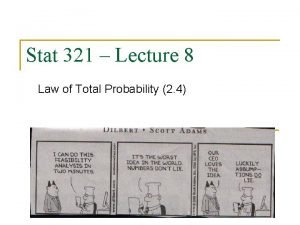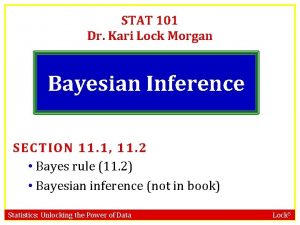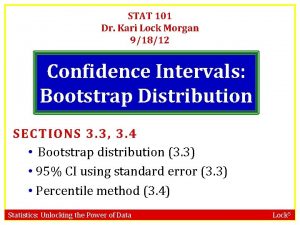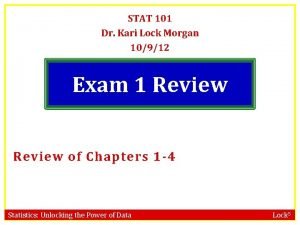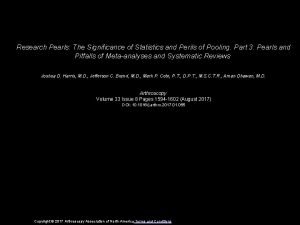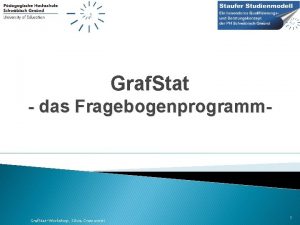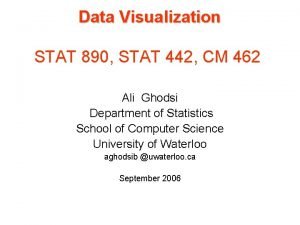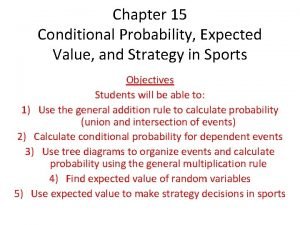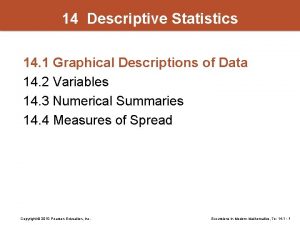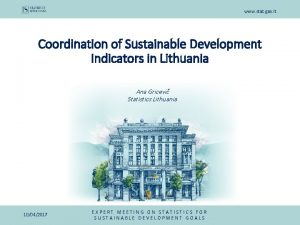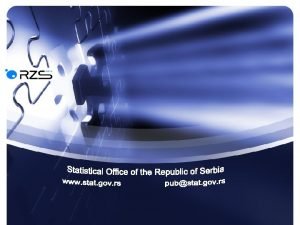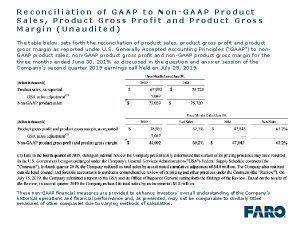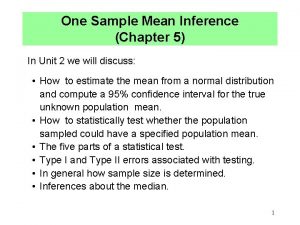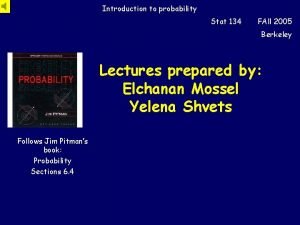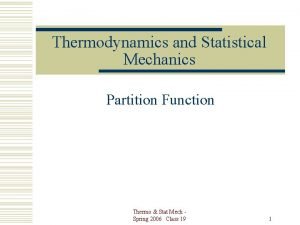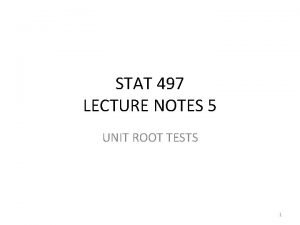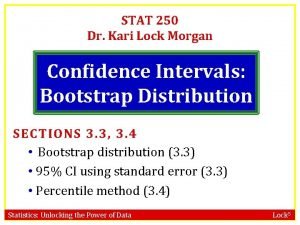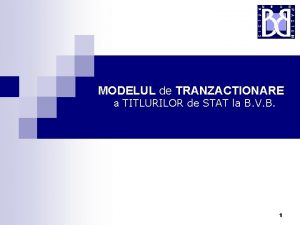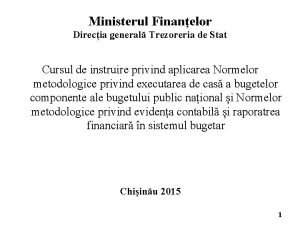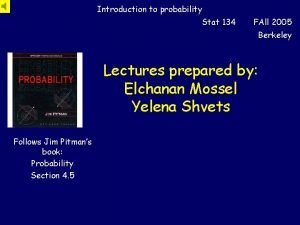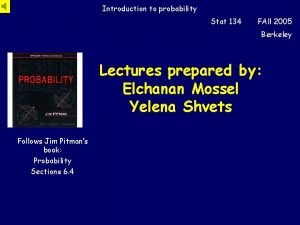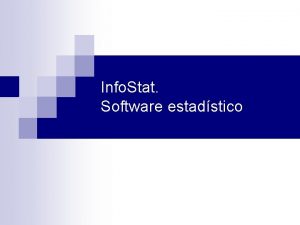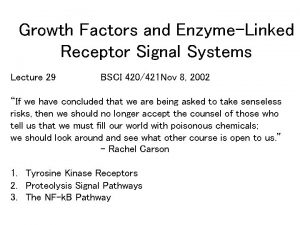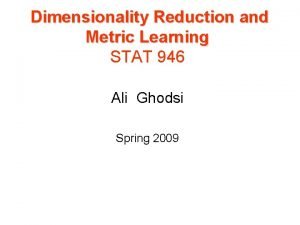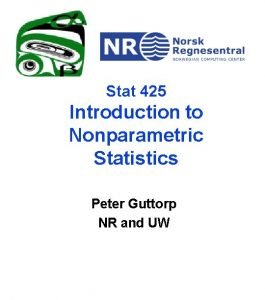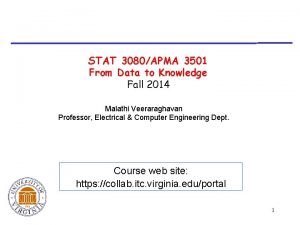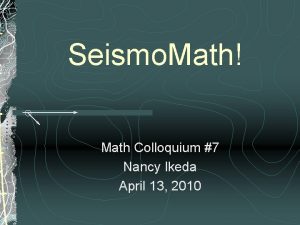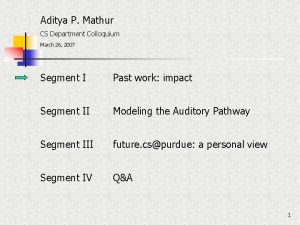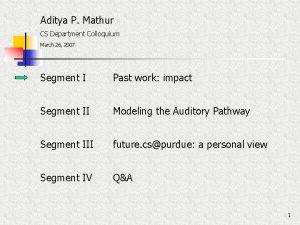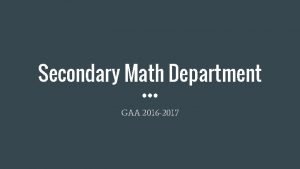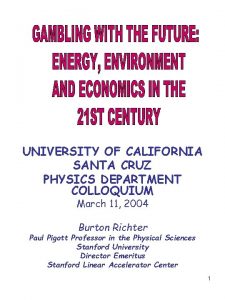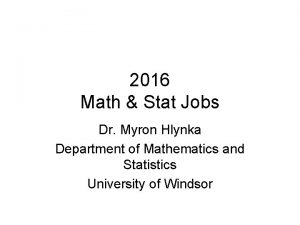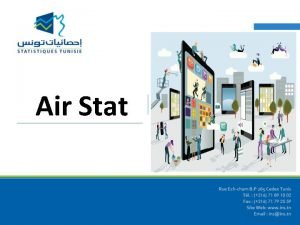Math Stat Department Colloquium Georgetown University March 20













![Gradient Method g x[0] x[1] x[2] x[3] Gradient Method g x[0] x[1] x[2] x[3]](https://slidetodoc.com/presentation_image_h2/c129dae9b7aba0f61d22548687347d08/image-14.jpg)
![Gradient Method g x[0] x[1] x[2] x[3] g Gradient Method g x[0] x[1] x[2] x[3] g](https://slidetodoc.com/presentation_image_h2/c129dae9b7aba0f61d22548687347d08/image-15.jpg)
![Gradient Method g x[0] x[1] x[2] x[3] g Gradient Method g x[0] x[1] x[2] x[3] g](https://slidetodoc.com/presentation_image_h2/c129dae9b7aba0f61d22548687347d08/image-16.jpg)












































































































- Slides: 124

Math & Stat Department Colloquium Georgetown University March 20, 2020

Security and Privacy for Distributed Optimization and Learning Nitin Vaidya Georgetown University

Goals g Background g Problem formulation g Intuition No theorems/proofs

Rendezvous 4

Rendezvous g g X g 5

g

Averaging g 7

Averaging g

Machine Learning g Data is distributed across different agents Agent 1 Agent 2 Agent 3 Agent 4

g Data is distributed across different Collaborate to learn agents

Machine Learning g g

Classification G. Renee Guzlas

g
![Gradient Method g x0 x1 x2 x3 Gradient Method g x[0] x[1] x[2] x[3]](https://slidetodoc.com/presentation_image_h2/c129dae9b7aba0f61d22548687347d08/image-14.jpg)
Gradient Method g x[0] x[1] x[2] x[3]
![Gradient Method g x0 x1 x2 x3 g Gradient Method g x[0] x[1] x[2] x[3] g](https://slidetodoc.com/presentation_image_h2/c129dae9b7aba0f61d22548687347d08/image-15.jpg)
Gradient Method g x[0] x[1] x[2] x[3] g
![Gradient Method g x0 x1 x2 x3 g Gradient Method g x[0] x[1] x[2] x[3] g](https://slidetodoc.com/presentation_image_h2/c129dae9b7aba0f61d22548687347d08/image-16.jpg)
Gradient Method g x[0] x[1] x[2] x[3] g

Distributed Optimization g 17

1984 18

Architectures g g g Server 1 g g

Distributed Optimization Iterative algorithm g Each agent maintains local estimate of optimum x g Local estimates shared with neighbors in each iteration g Local estimates converge to optimum 20

x 1 x 2 x 3 x 3 Example based on [Nedic and Ozdaglar, 2009]

x 1 x 2 x 3 x 3 g

x 1 x 2 x 3 x 3 g g

Distributed Optimization In the limit as t ∞ g Consensus: All agents converge to same estimate g Optimality 24

Why does this work?

Architectures g g g Server 1 g g

Parameter Server g g Server

Parameter Server g g

Parameter Server g g

Parameter Server g g

Many Variations Server … stochastic optimization … asynchronous … gradient compression … acceleration … shared memory

Architectures g g g Server 1 g g

Challenges

Challenges g Fault-tolerant distributed optimization f 1(x) + f 2(x) + f 3(x) How to optimize if agents inject bogus information? Server g g

Challenges g Privacy-preserving distributed optimization g How to collaborate without revealing own cost function? g

Fault-Tolerant Optimization 2015 …

Byzantine Fault Model g No constraint on misbehavior of faulty agents

Rendezvous g g X g 38

Rendezvous g g X g 39

Machine Learning Faulty agent can adversely affect model parameters g g g

Fault-Tolerance g What should be the objective of fault-tolerant optimization? 41

Fault-Tolerance g What should be the objective of fault-tolerant optimization? g Optimize over only good agents … set G

Fault-Tolerance g What should be the objective of fault-tolerant optimization? g Optimize over only good agents … set G g

Parameter Server g g

Parameter Server g g g

g ? Is a this c ble a v hie

g ? Is It Depends a this c ble a v hie

g ? Is a this ble a v hie c It Depends Independent functions “Enough” redundancy

Independent Functions a b c

Independent Functions a b c

Independent Functions a b c

Independent Functions a b c

Independent Functions Provably impossible to compute g

g Independent functions Approximate lele? ? b b a a vv e e i i h h aacc s s i i th Is. Isth “Enough” redundancy Exact

g Independent functions Approximate lele? ? b b a a vv e e i i h h aacc s s i i th Is. Isth “Enough” redundancy Exact

An Example of Redundancy g g

n=6 t=1 (number of agents) (faulty agents) G. Renee Guzlas

n=6 t=1 (number of agents) (faulty agents) G. Renee Guzlas

Parameter Server g g g

Norm Filter g g 60

Norm Filter g g g g

Norm Filter g g g g Exact optimum computed despite faulty agents

Another Example of Redundancy 63

Another Example of Redundancy g Machine learning Agent 1 g Agents draw samples from identical data distribution g Filter on stochastic gradients Agent 2

g Independent functions Approximate lele? ? b b a a vv e e i i h h aacc s s i i th Is. Isth “Enough” redundancy Exact

How to Approximate g ? 66

How to Approximate g ? g 67

How to Approximate g g g Ideal goal: Equal weight for all non-faulty agents ?

How to Approximate g g g Ideal goal: Equal weight for all non-faulty agents g Approximation: Unequal weights ?

Results g For each faulty agent, a good agent may be ignored Weight 0

Results g g

Results g g For each faulty agent, a good agent may be ignored Weight 0 But remaining good agent can get almost uniform importance 72

Results g Cannot compute g

Results g g

Parameter Server g g g

Privacy-Preserving Optimization 2016 …

Communication Leaks Information g Server g g

Communication Leaks Information g Server g g Server can use gradients to infer polynomial cost functions (up to a constant)

Related Work Cryptographic Methods Transformation Methods g Differential Privacy Query g Perturbed Output Database + Noise

Our Approach g Motivated by secret sharing & differential privacy Add cancellable noise 80

Multiple Parameter Servers consensus step Server 1 Server 2 g 81

Improving Privacy Server 1 Server 2 g g ε 1 + ε 2 = 0 over time 82

Convex Sum of Non-Convex Functions Server 2 Server 1 g g g

Convex Sum of Non-Convex Functions Server 2 Server 1 g g g “Privacy” if at least one server is non-adversarial

Privacy Fault-tolerance Gradient filters Cancellable noise Server g g g 1 g g

Decentralized Control/Optimization Distributed Computing Picture from Wikipedia 86

Lili Su Shripad Gade Dimitrios Pylorof Nirupam Gupta Shuo Liu

Thanks! disc. georgetown. domains

Net-X: Multi. Channel Mesh capacity D E Fixed F B A Switchable C channels Theory to Practice Net-X testbed Capacity bounds Insights on protocol design OS improvements Software architecture User Applications Multi-channel protocol IP Stack ARP Channel Abstraction Module Linux box CSL Interface Device Driver 89

Hajnal 1958 Weak ergodicity of nonhomogeneous Markov chains Distributed Computing De. Groot 1974 Reaching a consensus 1980: Pease, Shostak, Lamport Byzantine consensus 1983: Fischer, Lynch, Paterson Decentralized Control Tsitsiklis 1984 Asynchronous consensus impossibility result Jadbabaei, Lin, Morse 2003 Flocking problem Nedich, Ozdaglar 2009 1986: Dolev et al. Approximate Byzantine consensus

Distributed Optimization g g Each agent maintains an estimate g Local estimates shared with neighbors & updated g Estimates converge to optimum 91

x 1 x 2 x 3 x 3 Example based on [Nedic and Ozdaglar, 2009]

x 1 x 2 x 3 x 3 g

x 1 x 2 x 3 x 3 g g

Distributed Optimization As time ∞ g Consensus: All agents converge to same estimate g Optimality g 95

t faulty agents

t faulty agents g g Discard smallest t and largest t gradients Average the rest

t faulty agents g Discard smallest t and largest t gradients Average the rest g t=1 g g

t faulty agents g Discard smallest t and largest t gradients Average the rest g t=1 g g What does this achieve?

Our Ideal Goal g g 100

Independent Functions How good an approximation? g Instead of uniform weights g the filter achieves unequal weights g

Independent Functions g Cost functions of faulty nodes “filtered away”

Independent Functions g Cost functions of faulty nodes “filtered away” At most t good cost functions also filtered away

Independent Functions g Cost functions of faulty nodes “filtered away” At most t good cost functions also filtered away Nearly uniform importance to the remaining costs

Independent Functions How good an approximation? g g 0 0 ¼ ¼ 0 0

Independent Functions How good an approximation? g g 0 0 ¼ ¼ 0 0 g ⅛ ⅛ ¼ ¼ 0 0

Independent Functions g

Good News Cost functions often naturally redundant

Good News Cost functions often naturally redundant g Data sets at different agents may be drawn from same distribution In expectation, all cost functions are identical

Good News Cost functions often naturally redundant g Data sets at different agents may be drawn from same distribution In expectation, all cost functions are identical g Observations by different agents conditioned on the same ground truth

Good News Cost functions often naturally redundant g g 111

Linear Regression

Linear Regression g

Linear Regression g g

Linear Regression g g =

Distributed Linear Regression g 116

Distributed Linear Regression g g g =

Distributed Linear Regression g g g =

Server g g g 119

2 t-Redundancy … Linear Regression g 120

2 t-Redundancy … Linear Regression g

Privacy Techniques Differential privacy … add noise ε g Server g g

Privacy Techniques Differential privacy … add noise ε g Server g g Optimality compromised due to the noise g g

Privacy Techniques Homomorphic encryption g Expensive 124
 Sudbury colloquium
Sudbury colloquium Georgetown biology department
Georgetown biology department March march dabrowski
March march dabrowski Georgetown university mission statement
Georgetown university mission statement Georgetown university communication culture and technology
Georgetown university communication culture and technology Georgetown university communication culture and technology
Georgetown university communication culture and technology Georgetown university communication culture and technology
Georgetown university communication culture and technology Isabel darcy
Isabel darcy Anne rosenwald
Anne rosenwald Addison woods georgetown
Addison woods georgetown Martin ravallion georgetown
Martin ravallion georgetown Nathan edwards georgetown
Nathan edwards georgetown Georgetown school of continuing studies reputation
Georgetown school of continuing studies reputation Oded meyer georgetown
Oded meyer georgetown Grace yang georgetown
Grace yang georgetown Artemis kirk
Artemis kirk Georgetown mantra 4 principles
Georgetown mantra 4 principles Uta maa
Uta maa Math department meeting agenda
Math department meeting agenda Math department wvu
Math department wvu City tech math department
City tech math department Usm math department
Usm math department Purdue math
Purdue math The math department at a small school has 5 teachers
The math department at a small school has 5 teachers Oklahoma state standards
Oklahoma state standards Nku math department
Nku math department Haverford biology
Haverford biology Ksu math department
Ksu math department Waterloo applied math
Waterloo applied math Department of law university of jammu
Department of law university of jammu Department of geology university of dhaka
Department of geology university of dhaka Mechanicistic
Mechanicistic University of bridgeport it department
University of bridgeport it department Sputonik v
Sputonik v Psychology texas state
Psychology texas state Department of information engineering university of padova
Department of information engineering university of padova Information engineering padova
Information engineering padova Manipal university chemistry department
Manipal university chemistry department Syracuse university psychology department
Syracuse university psychology department Jackson state university finance department
Jackson state university finance department Webnis
Webnis Michigan state university physics department
Michigan state university physics department Columbia university cs department
Columbia university cs department University of sargodha engineering department
University of sargodha engineering department Stanford university philosophy department
Stanford university philosophy department Topmarks
Topmarks Math enrichment carleton
Math enrichment carleton Unproctored placement assessment
Unproctored placement assessment Simbolurile de stat ale republicii moldova ppt
Simbolurile de stat ale republicii moldova ppt Idexx proteinuria
Idexx proteinuria Mobile hdr ue4
Mobile hdr ue4 Otrokářský stát znaky
Otrokářský stát znaky Quirks stat testing
Quirks stat testing Sys stat h
Sys stat h Statquest josh starmer
Statquest josh starmer Gak syngende din ven i møde
Gak syngende din ven i møde Aliquid stat pro aliquo
Aliquid stat pro aliquo Ap stat phantoms
Ap stat phantoms Stat 324
Stat 324 Struct stat
Struct stat Kadinin stat?s?
Kadinin stat?s? Kadinin stat?s?
Kadinin stat?s? Stat 134 berkeley
Stat 134 berkeley How to find f stat
How to find f stat Franta vecini
Franta vecini How to find the t score for a confidence interval
How to find the t score for a confidence interval Stat key lock
Stat key lock Tuaregovia rasa
Tuaregovia rasa Stat quest
Stat quest Stat e-100
Stat e-100 Stat 301
Stat 301 Stat 280
Stat 280 Městský stát sparta
Městský stát sparta Stat transfer
Stat transfer My stats lab
My stats lab Embroic
Embroic Hypothesis testing formulas
Hypothesis testing formulas Jak se stát arteterapeutem
Jak se stát arteterapeutem Izodens
Izodens Turk stat
Turk stat Stat
Stat Stat mech
Stat mech Third tds equation
Third tds equation Stat mech
Stat mech Stat key
Stat key Stat 321
Stat 321 Stat 101
Stat 101 Statkey lock
Statkey lock Stat 101
Stat 101 Stat 101
Stat 101 Stat pearls impact factor
Stat pearls impact factor Stat cr
Stat cr Fragebogenerstellung
Fragebogenerstellung Stat 442
Stat 442 Stat 1000 pitt
Stat 1000 pitt Conditional expected value
Conditional expected value Stat 101
Stat 101 Stat.gov.lt
Stat.gov.lt Myanmar bbc timeline
Myanmar bbc timeline Www.stat.gov.rs
Www.stat.gov.rs 301 day
301 day Osnova sloh
Osnova sloh Stat to gaap reconciliation
Stat to gaap reconciliation Meaning of stat
Meaning of stat Stat 134
Stat 134 Spleen not palpable
Spleen not palpable Stat
Stat Partition function in statistical mechanics
Partition function in statistical mechanics Stat
Stat Unit root time series
Unit root time series Lock 5 stat
Lock 5 stat Simbolul moldovei
Simbolul moldovei Cvičenia na priamu reč
Cvičenia na priamu reč Calculator titluri de stat
Calculator titluri de stat Ministerul finantelor trezoreria de stat
Ministerul finantelor trezoreria de stat Stat 134
Stat 134 Stat 134
Stat 134 Infostat full
Infostat full Jak stat pathway interferon
Jak stat pathway interferon Finann
Finann Stat 946
Stat 946 Nejvyspělejší stát východní afriky
Nejvyspělejší stát východní afriky Stat 425
Stat 425 Stat 350
Stat 350 Stat 3080 uva
Stat 3080 uva
